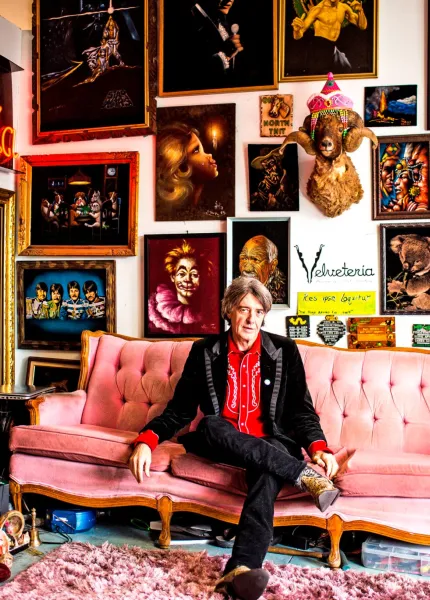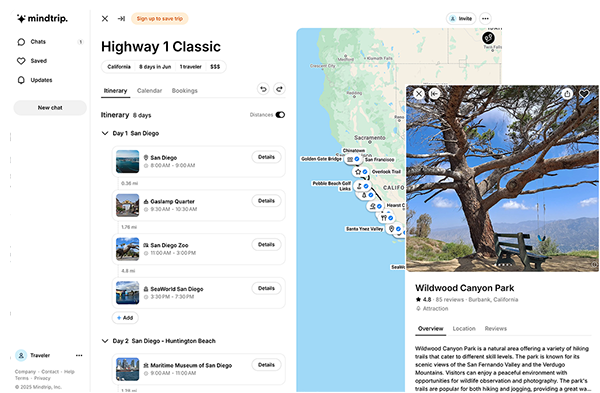Quirky Museums
This drive from L.A. to the Coachella Valley includes everything from Soviet-era art to a museum celebrating classic American hot rods.

Trip Itinerary Overview
7 stops on this route
Stop 1
Culver City
Stop 2
Velveteria
Stop 3
Bunny Museum
Stop 4
Wally Parks NHRA Motorsports Museum
Stop 5
Raymond M. Alf Museum of Paleontology
Stop 6
Historical Glass Museum
Stop 7
Cabot’s Pueblo Museum
Car & RV Rentals
Trusted car & RV rental companies make your trip much easier
Discover More of California
Stop 1: Culver City
Best known for its movie studios, Culver City is also where you’ll find a pair of Southern California’s most distinctive museums. In a renovated 1949 armory, the Wende Museum of Cold War History preserves artifacts from Eastern Bloc countries that were salvaged by its founder Justinian Jampol—including the largest section of the Berlin Wall outside of that city. At the Museum of Jurassic Technology, you’ll find an assortment of seemingly unrelated exhibits (decaying dice, miniature Disney figures) that share one thing in common: the unorthodox sensibility of museum founder David Wilson, recipient of a coveted MacArthur Foundation “genius” grant. As for moviemaking in Culver City, tours at Sony Pictures Studios lead through this historic lot—formerly MGM Studios—where such classics as The Wizard of Oz were filmed. Speaking of Oz, the restored Culver Hotel is where most of the movie’s cast, including all 124 of the actors who played Munchkins, stayed during production.
Planning Resources
- Culver City – https://www.discoverlosangeles.com/visit/hidden-gems-in-culver-city
Stop 2: Velveteria
Lovers of black velvet and Elvis will feel like they’ve died and gone to Graceland at Velveteria, the world’s only art museum dedicated to velvet art. (Ed. note: Velveteria closed permanently in 2021.) Located in Chinatown, this reliquary is jam-packed with masterpieces of the genre that celebrate the King, American presidents, and many others. You’ll see poker-playing dogs and one painting that brings together UFOs and Bigfoot. There are also works portraying crying clowns, a bevy of pin-ups, and a hall of fame assortment of rock stars. You want Picassos? Try the Los Angeles County Museum of Art. But if you want to see Elvis, Marilyn Monroe, and James Dean riding bareback on unicorns, Velveteria is definitely your kind of museum.
Planning Resources
- Discover Los Angeles – http://www.discoverlosangeles.com/
Stop 3: Bunny Museum
Hop over to Altadena to see the Bunny Museum, a veritable Lepus Louvre thanks to an ever-growing collection of more than 35,000 rabbit-related items from all over the world—among them, nine figures that once rode on Rose Parade floats. (Ed. note: As a result of the January 2025 L.A. fires, the Bunny Museum is closed. See their website to learn about rebuilding efforts.) Even if rabbits aren’t your habit, the museum, once dubbed “the hoppiest place on Earth,” will help you develop a deeper appreciation of the surprisingly rich and complex cultural history of bunnies. If there’s a cuter museum anywhere, please let us know. We’re all ears.
Planning Resources
- The Bunny Museum – http://www.thebunnymuseum.com/
Stop 4: Wally Parks NHRA Motorsports Museum
It’s no secret: Southern California loves its cars. And the region’s enduring racing tradition is celebrated at Pomona’s Wally Parks NHRA Motorsports Museum. Named for Wally Parks, who helped take drag racing from its amateur days on the street and turned it into a major professional sport, the museum is filled with the fast and furious through the generations. You’ll see historic dragsters and hot rods, as well as vintage land speed racers like Mickey Thompson’s Challenger I streamliner, the first automobile driven by an American to break the 400-mph barrier.
Planning Resources
- Walter Parks NHRA Motorsports Museum – https://nhramuseum.org/
Stop 5: Raymond M. Alf Museum of Paleontology
In the leafy precincts of the college burg of Claremont, the Raymond M. Alf Museum of Paleontology is not only notable for an assortment of dinosaur remains, it’s also the country’s only nationally accredited museum on a high school campus. The museum traces its origins to Raymond M. Alf, a teacher at The Webb Schools, whose fossil collection grew so large that the school decided to build a permanent museum. The towering Allosaurus skeleton is especially impressive, while the museum’s Hall of Footprints displays one of the country’s largest collections of fossil trackways (trackways are the fossilized footprints and other markings, such as tail drags, left by animals on a landscape).
Planning Resources
- Raymond M. Alf Museum of Paleontology – https://www.alfmuseum.org/
Stop 6: Historical Glass Museum
The delicate treasures at the Historical Glass Museum in the classic citrus town of Redlands are worth a visit. Housed in a 1903 Victorian, the collection dates to the 1830s and traces the evolution of American glassmaking—an exquisite tradition that had nearly died out by the time the museum was founded in the 1970s. The museum exhibits changing displays of works made by leading glass factories and artists and has one of the largest collections of its kind in the western United States.
Planning Resources
- Historical Glass Museum – https://www.facebook.com/p/Redlands-Historical-Glass-Museum-100057026487223/
Stop 7: Cabot’s Pueblo Museum
Back in 1941, adventurer and artist Cabot Yerxa began building this 35-room Hopi-inspired compound in Desert Hot Springs from handcrafted adobe bricks and materials he found in the desert. At Cabot’s Pueblo Museum, docents lead tours and tell Yerxa’s story, which ranged from Alaska’s Klondike gold fields to the art salons of Paris. Stop into the trading post to treat yourself to such authentic folk art as Hopi katsinas and elaborately painted Oaxacan wood carvings.
Planning Resources
- Cabot's Pueblo Museum – https://cabotsmuseum.org/
- Desert Hot Springs – https://www.visitgreaterpalmsprings.com/blog/post/hot-water-guide-to-desert-hot-springs/




















